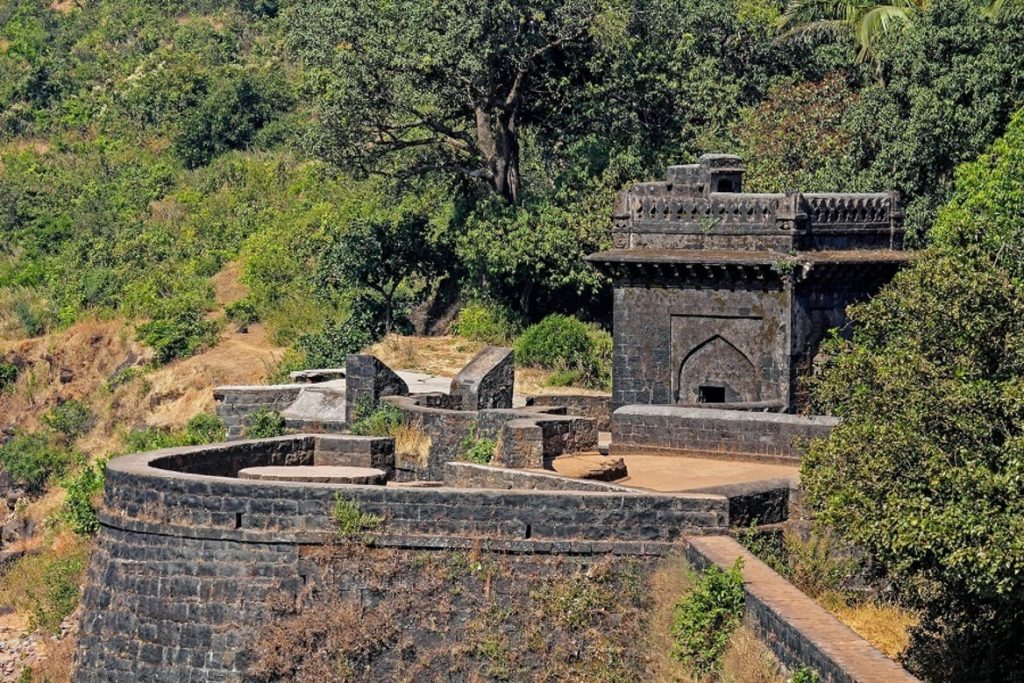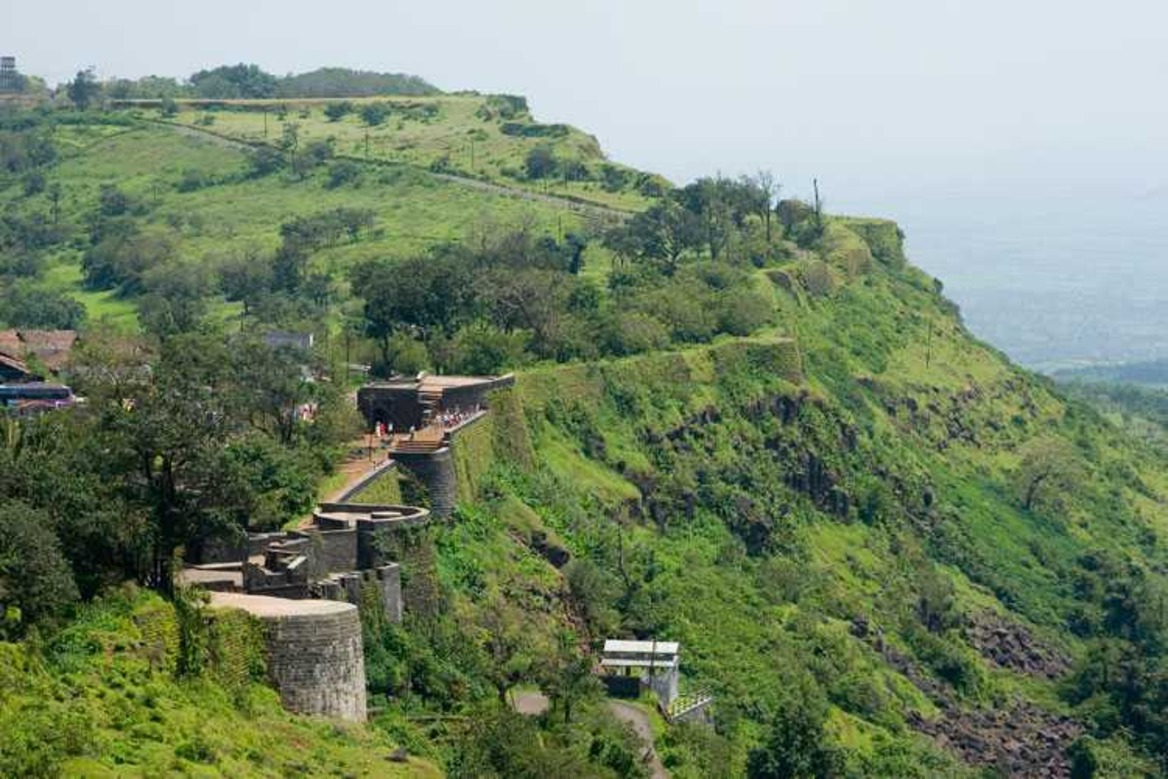Panhala Fort Information: Panhala Fort, also called Panhalgad and Panhalla (literally, “the home of serpents”), lies in Panhala, Maharashtra, India, 20 kilometers northwest of Kolhapur. Its advantageous location overlooks a pass in the Sahyadri mountain range, which served as a vital commercial route connecting coastal towns and Bijapur, Maharashtra’s interior. Owing to its advantageous position, the Marathas, the Mughals, and the British the grandsons of Chhatrapati Shivaji Maharaj East India Company fought multiple battles in the Deccan there, the most famous of which was the Battle of Pavan Khind. Tarabai Ranisaheb, the queen regent of Kolhapur, spent her early years in this place. The fort’s structures and several of its components are still standing. Its zigzagged design also earned it the name “Fort of Snakes.”
Panhala fort Information: History Of Panhala Fort
Shilahara ruler Bhoja II constructed one of the fifteen forts, Panhala Fort, between 1178 and 1209 CE. Other forts built by him include Bavda, Bhudargad, Satara, and Vishalgad. In active voice, the phrase “Kahaan Raja Bhoj, kahan Gangu Teli” translates to “Where is King Bhoj, and where is Gangu Teli?”. Raja Bhoja held court in Panhala between 1191 and 1192 CE, according to a copper plate discovered in Satara. After Singhana (1209–1247) of the Devgiri Yadavas defeated Bhoja Raja in 1209–10, the Yadavas took over the fort. It seems that subsequent neglect led to its governance passing through various local chiefs. Inscriptions from 1376 mention Nabhapur town, located southeast of the fort. (Panhala fort Information)
It was a Bahamanis of Bidar outpost. During 1469’s rainy season, renowned prime minister Mahmud Gawan set up camp here. After establishing the Adil Shahi dynasty in 1489, Bijapur incorporated Panhala into its territories and heavily fortified Panhala. It took them a century to construct the fort’s robust ramparts and entrances, according to legend. Many inscriptions in the fort mention Ibrahim Adil Shah’s reign, most likely Ibrahim I (1534–1557).
Panhala Fort Under Shivaji Maharaj
Shivaji Maharaj captured Panhala fort from Bijapur in 1659 after the chaos that accompanied the death of Afzal Khan, the commander of Bijapur. Adil Shah II (1656–1672) of Bijapur sent his army, led by Siddi Johar, to lay siege to Panhala in May 1660 in an attempt to retake the fort from Shivaji. They were unable to seize the fort because Shivaji retaliated. After enduring a siege for 5 months, the fort’s supplies had depleted, and Shivaji faced the danger of being taken prisoner. (Panhala fort Information)
Shivaji Maharaj concluded that his only choice was to leave in these conditions. Along with his loyal commander Baji Prabhu Deshpande, he gathered a handful of men, and on July 13, 1660, they escaped into the night to reach Vishalgad. Baji Prabhu and a barber named Shiva Kashid, who resembled Shivaji, kept the adversary distracted by giving the impression that Shiva Kashid was Shivaji. Nearly three-quarters of the one thousand-strong troop, including Baji Prabhu, perished in the ensuing combat. Adil Shah inherited the fort. Shivaji Maharaj could not occupy it permanently till 1673.
Shivaji Maharaj finally got to meet his courageous son after he managed to flee Diler Khan’s camp and carry out his father’s political scheme to convert Aurangzeb’s heir to Maratha rule. On December 13, 1678, he and his spouse fled from this place and launched an attack on Bhupalgad. But on December 4, 1679, he went back to Panhala to make amends with his father, who passed away on April 4, 1680. In 1678, when Shivaji Maharaj was at his strongest, Panhala could accommodate 20,000 men and 15,000 horses. Chaar Darwaza was also the primary darwaza.

Panhala Fort Under the Kolhapur kings
Sambhaji Maharaj succeeded in falling his stepbrother Rajaram I and becoming the Chhatrapati of the Maratha Empire after Shivaji Maharaj passed away. He was able to persuade the garrison at Panhala to support him in this endeavor. The Mughals came to control the fort in 1689 after Aurangzeb’s general Mukkarab Khan imprisoned Sambhaji Maharaj at Sangameshwar. But in 1692, Kashi Ranganath Sarpotdar, under the direction of Maratha garrison commander Parshuram Pant Pratinidhi, retook the fort of Vishalgad. Panhala at last submitted to Aurangzeb in 1701, when he personally arrived for it. On April 28, 1692, the Mughal Emperor notably received the English ambassador Sir William Norris at Panhala Fort. In fruitless negotiation, Norris reportedly spent 300 pounds with Aurangzeb. The Maratha troops led by Ramchandra Pant Amatya retook the fort in a matter of months. (Panhala fort Information)
Aurangzeb attacked it once more in 1693. This resulted in an additional protracted siege during which Rajaram fled to Gingee Fort dressed as a beggar, abandoning his 14-year-old wife Tarabai Ranisaheb at Panhala. Tarabai Ranisaheb would remain in Panhala for nearly five years till she was reunited with her husband while Aurangzeb was pursuing Rajaram. Tarabai Ranisaheb handled the fort’s management, settled conflicts, and won the populace’s respect during this pivotal time in her life. Her tenure in Panhala gave her judicial experience and the backing of her officers, both of which would play a role in subsequent developments. Rajaram did dispatch forces from Gingee, and in October 1693 Maratha captured Panhala.
When Rajaram passed away in 1700, his wife Tarabai left behind Shivaji II, a 12-year-old son. With Panhala as her capital, Tarabai established an autonomous kingdom in 1705 under the name of her son Shivaji II and ruled it as regent. After Tarabai Ranisaheb’s defeat by Satara’s Shahuji in 1708, Tarabai escaped to Malvan in Ratnagiri, while Shahu captured Panhala. Soon later, in 1709, Tarabai conquered Panhala once more and founded Kolhapur Rajaram, a distinct state. His second wife, Rajasbai Ranisaheb, succeeded to the throne. Unharmed, he passed away in 1760.
Jijabai Ranisaheb, his widow, adopted a Sahaja Bhonsale of Canvas’s son. Because of this, Jijabai Ranisaheb took on the role of acting regent while her adopted son was a minor. She eventually came to think that human blood had to be formally offered to Goddess Kali at the Mahakali shrine at the fort in order to save Panhala from falling. Occasionally, at night, she would dispatch her soldiers to search the nearby villages for casualties. She would carry on with this habit until she died in 1772. The Kali tower is still the name of one of the towers. That was close to the location of these sacrifices. According to some accounts, Jijabai Ranisaheb gave an oilman or Teli a piece of land in exchange. For his daughter-in-law’s consent to be buried alive beneath one of the Panhala towers.
Conclusion
Panhala Fort is an interesting example of Maratha history that provides insight into Maharashtra’s past and present. Travelers who enjoy history, the outdoors, and adventure will find Panhala Fort to be a terrific location. Because to its many attractions, activities, and services. Panhala Fort has multiple journey options and is accessible by a range of transportation means. Additionally, Panhala Fort offers some safety guidelines, advice, and emergency services to guarantee the visitors’ security and comfort.

